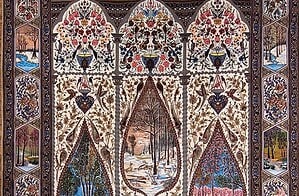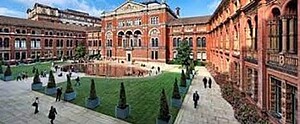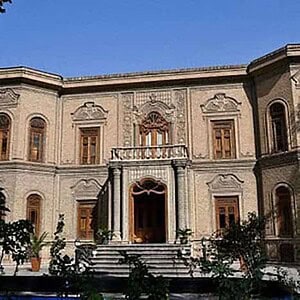
Embark on a voyage where art and history meld harmoniously, unveiling stories woven through intricate threads of ancient civilizations. Immerse yourself in the captivating universe of ageless Persian rugs, where time-defying beauty merges with cultural heritage. Join us as we explore ancient Persian rugs in world-class museums worldwide that house these exceptional relics.
At Beautiful Rugs, our fervor for these Persian masterpieces drives us to celebrate their artistry and legacy. This blog post guides you through a spellbinding journey across renowned global museums, each adorned with an extraordinary collection of Persian rugs. Together, we’ll unfurl their storied past, decipher their cultural importance, and admire the craftsmanship that has enthralled generations.
From New York City’s grand halls in The Metropolitan Museum of Art to London’s resplendent galleries at the Victoria and Albert Museum, prepare to be captivated by these age-old tapestries’ grandeur. We’ll venture to Paris’s Louvre Museum, where artistic ingenuity converges with Persian finesse, and Russia’s Hermitage Museum in St. Petersburg, offering regal opulence.
Yet, our odyssey extends further. We’ll uncover ancient Persian rugs magnificence in other exceptional world-class museums: Doha’s Museum of Islamic Art, Tehran’s Carpet Museum of Iran, and Istanbul’s Topkapi Palace Museum. Each venue presents a distinct perspective, enriching our comprehension of this timeless art form.
By contrasting the diverse approaches taken by these museums, we’ll grasp their significant role in preserving and promoting Persian rug heritage. Discover how they curate exhibits, offer educational resources, and inspire a profound appreciation for these cultural gems.
Ancient Persian rugs in The Metropolitan Museum of Art, New York City

The New York Metropolitan Museum of Art.The Metropolitan Museum of Art, located in the bustling heart of New York City, stands as a testament to the power of art and culture. As the largest art museum in the Americas, this world-class museum offers a gateway to explore a vast collection that spans over 5,000 years of human creativity.
Within the hallowed halls of The Met, visitors can immerse themselves in the awe-inspiring world of ancient Persian rugs. With an extensive collection that showcases the historical significance of these masterpieces, The Met is a treasure trove for rug enthusiasts and history buffs alike.
Step into the galleries dedicated to Persian rugs, and you will be transported through time. Each rug encapsulates the stories of empires long gone, nomadic tribes on the move, and the enduring craftsmanship passed down through generations.
Notable exhibits within The Met’s collection include rugs from various periods, highlighting the evolution of Persian rug design and techniques. From the richly detailed floral motifs of the Safavid dynasty to the bold geometric patterns of the Qajar era, these rugs provide invaluable insights into Iranian art and culture.
One of the such noteworthy ancient persian rugs is the “Ardabil Carpet,” a masterpiece from the 16th century. This exquisite piece, known for its intricate design and exceptional craftsmanship, is a testament to the skill of Persian weavers. Its grandeur and timeless beauty are truly awe-inspiring.
To complement the physical exhibits, The Met also offers a range of online resources. Through their website, visitors can access detailed information about the Persian rug collection, delve into the historical context, and explore high-resolution images that capture every intricate detail.
These resources provide a deeper understanding of the rugs’ cultural significance and allow enthusiasts from around the world to engage with this remarkable collection. For those fortunate enough to visit in person, The Met offers a captivating experience. Wander through the galleries, marvel at the rugs’ intricate patterns, and let yourself be transported to a world steeped in history.
The grandeur of The Met’s Great Hall, filled with enthusiastic crowds, sets the stage for an unforgettable journey into the wonders of ancient Persian rugs.
All in all, the Metropolitan Museum of Art in New York City serves as a testament to the enduring allure and cultural significance of ancient Persian rugs.
Ancient Persian Rugs in the Victoria and Albert Museum, London

Located in the vibrant city of London, the Victoria and Albert Museum (V&A) stands as a testament to the power of art, design, and creativity. As the world’s largest world-class Museum of Applied Arts, decorative arts, and design, it offers visitors a captivating journey through centuries of human ingenuity.
Within the grand halls of the V&A, a significant collection of ancient Persian rugs awaits exploration. These rugs not only showcase the exquisite craftsmanship of Persian weavers but also hold immense cultural importance.
Step into the galleries dedicated to Persian rugs, and you will be mesmerized by the intricate patterns and vibrant colors that adorn these timeless masterpieces. Each rug tells a story, echoing the rich history and artistic traditions of Iran.
Notable exhibits within the collection include rugs from various periods, representing the diverse styles and techniques employed by Persian weavers throughout the ages. From the elegant floral motifs of the Safavid dynasty to the geometric precision of the Qajar era, these rugs offer a glimpse into the evolution of Persian rug design.
One remarkable rug on display is the “Ardabil Carpet.” Dating back to the 16th century, this extraordinary piece is renowned for its intricate design and exceptional craftsmanship. Its delicate details and harmonious color palette make it a true masterpiece of Persian artistry.
To delve deeper into the world of Persian rugs at the V&A, visitors can access the museum’s website and explore the wealth of information available online. The website offers detailed descriptions of the rugs, allowing enthusiasts to learn about their historical and cultural significance. Additionally, high-resolution images provide a close-up look at the intricate details woven into these magnificent creations.
A visit to the Victoria and Albert Museum is an immersive experience that brings together art, history, and design. As you wander through the galleries and admire the Persian rug collection, you will gain a deeper appreciation for the artistry and cultural heritage encapsulated within each rug.
The V&A is a haven for those captivated by the allure of ancient Persian rugs. It serves as a testament to their enduring legacy, preserving and celebrating their beauty for generations to come. Located amidst the vibrant energy of London, the Victoria and Albert Museum truly exemplifies the exploration of ancient Persian rugs in a world-class setting.
Louvre Museum Paris and the Magnificent Ancient Rugs

The Louvre Museum, located in the heart of Paris, is a global icon and a testament to the rich cultural heritage of France. As one of the world’s largest and most visited museums, it houses an extensive collection that spans centuries of human history and artistic expression.
Within the grand halls of the Louvre, visitors can immerse themselves in the captivating world of Persian rugs. These remarkable textiles not only showcase the artistry of Persian weavers but also hold immense artistic and cultural value.
The Louvre boasts a collection of Persian rugs that exemplifies the exquisite craftsmanship and design sensibilities of Iran. From the delicate floral patterns of the Safavid dynasty to the intricate geometric motifs of the Qajar period, these rugs offer a glimpse into the rich tapestry of Persian art.
Among the notable exhibits at the Louvre, one must-see rug is the “Spring Carpet.” Dating back to the 17th century, this exquisite piece embodies the beauty and elegance of Persian rug design. Its vibrant colors and harmonious patterns reflect the artistic vision that permeates Persian culture.
To further engage with the collection, visitors can access the Louvre Museum’s website and explore a wealth of online resources. The website offers detailed information about the Persian rug collection, including historical context and artistic significance. High-resolution images allow enthusiasts from around the world to appreciate the intricate details of these magnificent creations.
A visit to the Louvre Museum is a journey through time and culture. As you wander through the galleries, surrounded by masterpieces from various civilizations, the Persian rugs stand out as testaments to the enduring legacy of Iranian artistry. The grandeur of the Louvre’s architecture and the sheer vastness of its collection create an unforgettable experience that celebrates the beauty and cultural significance of ancient Persian rugs.
Hermitage Museum, St. Petersburg

Nestled in the historic city of St. Petersburg, the Hermitage Museum is a cultural jewel that houses one of the world’s most extensive and diverse art collections. With its opulent architecture and rich history, the museum offers a captivating journey through art and culture.
Among the treasures within the Hermitage’s vast collection, Persian rugs hold a significant place, embodying the artistry and cultural heritage of Iran. These rugs provide a glimpse into the historical context and artistic traditions of Persian weaving.
As you step into the galleries dedicated to Persian rugs, you are transported to a world of intricate designs and masterful craftsmanship. The collection of the Hermitage showcases the evolution of Persian rug design throughout different periods, from the early Safavid Dynasty to the Qajar and Pahlavi eras.
Noteworthy among the exhibits is the “Polonaise Carpet,” an exquisite rug from the 17th century. This remarkable piece features a captivating combination of floral and geometric motifs, reflecting the fusion of Persian and European influences during that era.
To further enhance your exploration, the Hermitage Museum provides access to its website, where visitors can delve into the rich history and cultural significance of Persian rugs. Online content includes detailed descriptions of the rugs, offering valuable insights into their artistic techniques and historical context. High-quality images enable enthusiasts to appreciate the intricate details of these magnificent textiles.
A visit to the Hermitage Museum is an immersive experience that allows you to witness the beauty and grandeur of Persian rugs firsthand. Surrounded by the museum’s ornate interiors, you can’t help but be captivated by the delicate patterns and vibrant colors that adorn these timeless masterpieces.
The Museum of Islamic Art, Doha, Qatar and Ancient Persian Rugs

Located at the southern end of Doha Bay, the Museum of Islamic Art (MIA) in Doha, Qatar, stands as a testament to the rich cultural heritage of Islamic art. Designed by renowned architect I. M. Pei, the museum offers visitors a captivating journey through centuries of artistic excellence.
Among the museum’s impressive collection, Persian rugs hold a prominent place, showcasing the intricate craftsmanship and artistic traditions of Iran. These rugs not only serve as exquisite floor coverings but also hold immense cultural significance.
The MIA’s collection features a range of Persian rugs, each telling a unique story through their designs and motifs. From the intricate floral patterns of the Safavid era to the geometric precision of later periods, these rugs offer a glimpse into the diverse styles and techniques employed by Persian weavers.
Notable exhibits include rugs from various historical periods, highlighting the evolution of Persian rug design and the cultural exchange between different regions. One standout piece is the “Ardabil Carpet,” renowned for its masterful artistry and historical importance.
To delve deeper into the world of Persian rugs at the MIA, visitors can access the museum’s website and explore a wealth of online resources. The website provides detailed information on the rugs, allowing enthusiasts to learn about their historical context and cultural significance. High-resolution images offer a closer look at the intricate details woven into these magnificent creations.
A visit to the Museum of Islamic Art in Doha is a captivating experience that celebrates the beauty and cultural legacy of Persian rugs. Amidst the museum’s remarkable architecture and extensive collection, these rugs serve as timeless reminders of the rich artistic traditions of Iran.
The Carpet Museum of Iran, Tehran

Located in Tehran, adjacent to Laleh Park, the Carpet Museum of Iran stands as a testament to the rich cultural heritage of Persian rugs. Established in 1976, the museum showcases an extensive collection of rugs from all over Iran, representing centuries of artistic excellence.
The museum’s collection includes a diverse array of Persian rugs, each with its own historical and artistic significance. From the intricate floral patterns of the Safavid era to the geometric precision of later periods, these rugs offer a glimpse into the remarkable craftsmanship and design traditions of Iran.
Among the notable exhibits at the Carpet Museum of Iran, one can find distinguished rugs such as the “Tabriz Medallion Carpet” and the “Ardabil Carpet,” both renowned for their exceptional artistry and historical importance. These rugs not only showcase the mastery of Persian weavers but also provide insights into the cultural and historical context of their creation.
To further explore the world of Persian rugs, visitors can access the museum’s website, which offers valuable information and resources. Online content provides in-depth insights into the history, techniques, and cultural significance of Persian rug weaving. Through high-resolution images and detailed descriptions, enthusiasts can appreciate the fine details and craftsmanship of these ancient textiles.
A visit to the Carpet Museum of Iran offers a unique opportunity to immerse oneself in the vibrant world of Persian rug artistry. Surrounded by the exquisite beauty of these masterpieces, visitors can gain a deeper appreciation for the cultural heritage and artistic legacy of Iran.
Topkapi Palace Museum, Istanbul, Turkey

The Topkapi Palace Museum in Istanbul, Turkey, is a majestic complex that offers a fascinating glimpse into the grandeur of the Ottoman Empire. As you step into this historical treasure, you’ll discover a collection of Persian rugs that adds to its allure and cultural significance.
The museum houses an impressive assortment of Persian rugs, each carrying its own historical context and artistic value. These rugs reflect the rich weaving traditions of Iran and the influence they had on the Ottoman Empire. They provide a window into the opulent lifestyle and refined tastes of the sultans and their courts.
Among the famous Persian rugs showcased at the Topkapi Palace Museum, the “Hunting Carpet” stands out as a masterpiece. This intricately woven rug features vibrant colors and depicts scenes of royal hunting expeditions. With its intricate details and remarkable craftsmanship, it has become an iconic symbol of Persian rug artistry.
To delve deeper into the world of these exquisite textiles, visitors can explore the museum’s website and access related online materials. The website offers valuable insights into the history and cultural significance of the Persian rugs on display. Through high-resolution images and detailed descriptions, enthusiasts can appreciate the intricate patterns and motifs that adorn these ancient treasures.
A visit to the Topkapi Palace Museum is an enchanting experience that transports you to the splendor of the Ottoman Empire. Amidst the breathtaking architecture and fascinating artifacts, the collection of Persian rugs serves as a testament to the enduring beauty and cultural heritage of Iran.
Importance of Visiting Museums
Visiting museums is an enriching experience that offers valuable insights into history, culture, and art. In the context of exploring ancient Persian rugs in world-class museums, these institutions provide a unique window into the past, allowing us to connect with the rich heritage of civilizations. Museums offer a tangible connection to the craftsmanship, stories, and artistic expressions of bygone eras.
By engaging with the intricacies of Persian rug collections, visitors appreciate the beauty of the artifacts and gain a deeper understanding of the cultural contexts in which they were created. Exploring these rugs within the museum’s curated environment enhances our appreciation for their significance and craftsmanship, offering a holistic perspective on their historical importance.
In an era of digital abundance, museums stand as physical repositories of cultural treasures, fostering a sense of discovery and learning. By visiting these institutions, we contribute to the preservation of heritage while expanding our own knowledge and horizons.
Beautiful Rugs: Connecting Past and Present
At Beautiful Rugs, we are committed to preserving the legacy of ancient Persian rugs and connecting the past with the present. Our collection is inspired by historical designs and craftsmanship, offering a timeless beauty that continues to captivate art enthusiasts and interior designers alike.
Moreover, we meticulously handcraft each rug using traditional techniques passed down through generations. We pay homage to the ancient traditions and patterns while infusing contemporary elements, resulting in exquisite pieces that bridge the gap between history and modernity.
Our collection showcases a range of Persian rugs, from intricate floral motifs to geometric patterns, highlighting the diverse artistic expressions found within this rich heritage. With our commitment to quality and authenticity, every rug tells a story and carries the essence of Persian culture, making it a cherished addition to any space.
Whether you are an avid collector or simply appreciate the beauty of these antique Persian rugs masterpieces, or breathtaking Persian pictorial rugs exploring Beautiful Rugs provides an opportunity to experience the timeless allure of Persian rugs. Each rug holds a unique character and charm, inviting you to create a connection with the past while adding a touch of elegance to your present.
Visit Beautiful Rugs and embark on a journey through time, where the artistry and craftsmanship of ancient Persian rugs seamlessly blend with the contemporary world. Discover the beauty and cultural richness that our rugs bring and let them inspire your own sense of style and appreciation for this timeless art form.
Conclusion: Museums That Have Ancient Persian Rugs
In conclusion, museums that house ancient Persian rugs provide visitors with a unique and enriching experience. These cultural institutions offer a deeper understanding of the artistry, history, and cultural significance of these remarkable textiles. Through immersive displays, informative exhibits, and educational programs, visitors can connect with the past, gaining insights into the societies that created these masterpieces. Moreover, by supporting these museums, individuals contribute to the preservation and promotion of Persian rug heritage for future generations to appreciate.